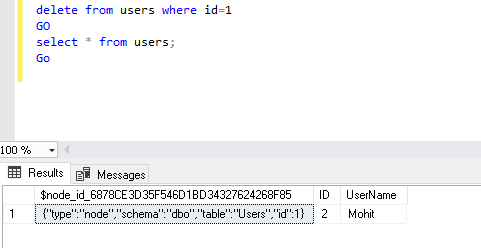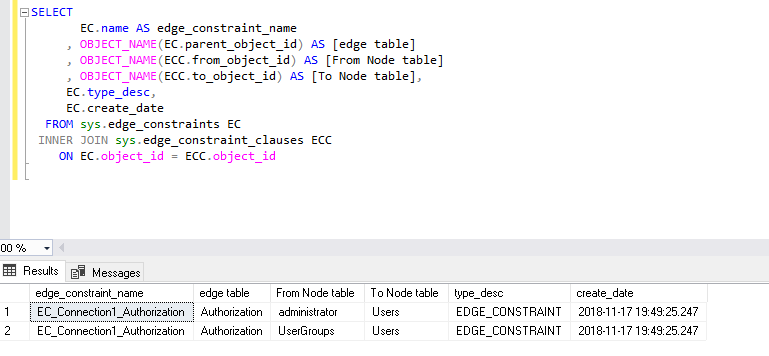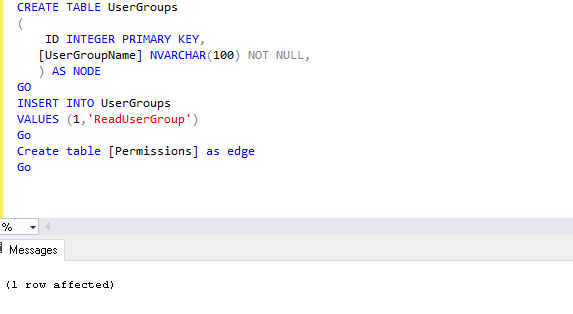SQL Server 2017 introduced Graph database features where we can represent the complex relationship or hierarchical data. We can explore the following articles to get familiar with the concept of the Graph database.
- An introduction to a SQL Server 2017 graph database
- How to implement a graph database in SQL Server 2017
Graph database contains the following elements
- Node: Nodes in graph database represents an entity i.e. customer, employee etc.
- Edge: Edge represents the relationship between nodes
SQL Server 2019 contains below enhancements for the Graph database.
- Edge Constraints (CTP 2.0)
- Match support in MERGE statement
- Use a derived table or view aliases in graph match query
In this article, we will view the edge constraint with SQL Server 2019 preview.
Edge Constraints (CTP 2.0) in SQL Server 2019
Typically, graph databases in SQL Server 2017 look as shown below. Here, you can see that an edge could connect any node to any other node. There were no restrictions on the edge connections. Edge is bidirectional in SQL Server 2017 i.e. edge can connect with any nodes in any direction.

Now let us consider a scenario where we want to place some restrictions on the edge that it should not be able to connect to each node. If someone tries to create an edge between those, it should generate an error.
Let us consider an example where we have two nodes:
- Administrators
- Users
We have an edge connecting these nodes i.e. ‘Authorization’ as shown here.

In the above example, the administrator can provide authorization to do any work to the user, but a user cannot give authorization for the administrator.
In SQL Server 2017, we create the nodes and edge table as shown below:
-
Create a sample database and Node table ‘administrator’:
12345678910Create database GraphDBGoUse GraphDBGoDROP TABLE IF EXISTS administratorCREATE TABLE administrator (ID INTEGER PRIMARY KEY, administratorName VARCHAR(100)) AS NODE;INSERT INTO administratorVALUES (1,'Rajendra')GoSELECT * FROM administrator

-
Create Node table ‘Users’ and insert data into it:
12345CREATE TABLE Users (ID INTEGER PRIMARY KEY, UserName VARCHAR(100)) AS NODE;INSERT INTO UsersVALUES (1,'Sonu')GoSELECT * FROM Users

-
Create edge table ‘ Authorization’ and connect the nodes around it:
123456789DROP TABLE IF EXISTS [Authorization]CREATE TABLE [Authorization] AS EDGEGoINSERT INTO [Authorization] ($from_id ,$to_id )VALUES ((SELECT $node_id from administrator where ID=1),(SELECT $node_id from Users where ID=1))select * from [Authorization]
Now let us insert one more record into users table.
|
1 2 3 |
INSERT INTO Users VALUES (2,'Mohit') Go |
In this step, let us try to insert an edge records from users to administrator node using the below query. It successfully inserted the record.
|
1 2 3 4 5 |
INSERT INTO [Authorization] ($from_id ,$to_id ) VALUES ( (SELECT $node_id from Users where ID=2), (SELECT $node_id from administrator where ID=1)) select * from [Authorization] |
You can notice here that we have inserted edge record from user to administrator while it is not our desired behavior. We want to restrict this behavior but SQL Server 2017 does not provide any options to do so.
Let us move to SQL Server 2019 and see what it offers for this problem.
SQL Server 2019 Edge constraints
In SQL Server 2019, we can define edge constraint. We can define the condition in the edge constraint from which edge could not connect.
For example, in our example, above we want a constraint from administrator to the user node. If someone tries to insert records from Users to Administrator, it should fail.

In SQL Server 2019, we can define contains as shown in below query. You can notice the difference in creating edge table in SQL Server 2017 and SQL Server 2019 preview.
In below query, we defined a constraint that allows connection from Node ‘Administrator’ To Node ‘Users’.
|
1 2 3 4 5 6 |
CREATE TABLE [Authorization] ( CONSTRAINT EC_Authorization Connection (Administrator TO Users) ) As Edge Go |

Now, we can connect the edge between nodes as usual way from the Node ‘Administrator’ To Node ‘Users’:
|
1 2 3 4 5 6 |
INSERT INTO [Authorization] ($from_id ,$to_id ) VALUES ( (SELECT $node_id from administrator where ID=1) ,(SELECT $node_id from Users where ID=1) ) select * from [Authorization] |
We defined constraint from Node ‘Administrator’ To Node ‘Users’ in edge table. Therefore, we will test inserting edge record from Node ‘Users’ to Node ‘Administrator’.
|
1 2 3 4 5 6 7 8 9 |
INSERT INTO Users VALUES (2,'Mohit') Go INSERT INTO [Authorization] ($from_id ,$to_id ) VALUES ( (SELECT $node_id from users where ID=2) ,(SELECT $node_id from administrator where ID=1) ) |
It fails with below error message. You can see in the error message that since we are trying to insert edge between Users to Administrator. It violates the edge constraint we defined with edge table.
Msg 547, Level 16, State 0, Line 19
The INSERT statement conflicted with the EDGE constraint “EC_Authorization”. The conflict occurred in database “GraphDB”, table “dbo.Authorization”.
The statement has been terminated.
Now let us add one more node Groups in our example. A user who is part of the group can have the required permissions. The graph should look like below.

-
Create Node ‘Usergroups’ and insert a record into it.
123456789CREATE TABLE UserGroups(ID INTEGER PRIMARY KEY,[UserGroupName] NVARCHAR(100) NOT NULL,) AS NODEGOINSERT INTO UserGroupsVALUES (1,'ReadUserGroup')Go -
Create Edge ‘permissions’
123Create table [Permissions] as edgeGo

Previously we have defined constraints that allow inserting from Node ‘administrators’ to Node ‘users’. Therefore, if we connect edge from Node ‘usergroups’ to Node ‘users’ we get below error message.
|
1 2 3 4 5 |
INSERT INTO [Authorization] ($from_id ,$to_id ) VALUES ( (SELECT $node_id from usergroups where ID=1) ,(SELECT $node_id from users where ID=1) ) |
We can define multiple constraints on an edge table. In below query, we have defined one more constraint to insert from Node ‘Usergroups’ to Node ‘Users’.
|
1 2 3 4 5 6 |
ALTER TABLE [Authorization] ADD CONSTRAINT EC_Connection1_Authorization Connection ( Administrator TO Users, UserGroups TO Users ) GO |

We can delete the old constraint since, in the above query, new constraint contains both the nodes.
|
1 2 |
ALTER TABLE [Authorization] DROP CONSTRAINT EC_Authorization GO |

|
1 2 3 |
INSERT INTO Users VALUES (3,'Akshita') Go |
Now let us test few scenarios to insert into edge table.
-
Insert into edge table from Node ‘Users’ to Node ‘administrator’: It gives an error message due to the defined constraint.
12345INSERT INTO [Authorization] ($from_id ,$to_id )VALUES ((SELECT $node_id from users where ID=2),(SELECT $node_id from administrator where ID=1))
-
Insert into edge table from Node ‘usergroups’ to Node ‘users’: It successfully inserts record as we have defined constraint to allow this.
12345INSERT INTO [Authorization] ($from_id ,$to_id )VALUES ((SELECT $node_id from UserGroups where ID=1), (SELECT $node_id from users where ID=1))

-
Insert into edge table from Node ‘users’ to Node ‘UserGroups’: We cannot insert record here due to the constraint does not allow going towards Node ‘users’ to Node ‘UserGroups’
123456INSERT INTO [Authorization] ($from_id ,$to_id )VALUES ((SELECT $node_id from users where ID=1),(SELECT $node_id from UserGroups where ID=1))
Delete records in a graph database with SQL Server 2019
In SQL Server 2017, we can delete any records from the graph database whether that contains the connecting edge into the graph or not. This imbalances the graph database since the edge is having no connections for the record. We cannot ensure data integrity in this case.
Let us delete a record in SQL Server 2017 from the table and records created earlier.

However, we can see that connecting edge already exist which should not be case ideally.
Now let us observe the same behavior with SQL Server 2019. You can see that delete statement fails with the error
Msg 547, Level 16, State 0, Line 3
The DELETE statement conflicted with the EDGE REFERENCE constraint “EC_Authorization”. The conflict occurred in database “GraphDB”, table “dbo.Authorization”.
The statement has been terminated.
System catalog views in SQL Server 2019 for edge constraints
SQL Server 2019 contains new system catalog view to get information about the defined edge constraints for SQL Server 2019.
- sys.edge_constraints: This system view show details about the edge constraint
- sys.edge_constraint_clauses: this system view shows details about clause of an edge constraint
We can join these system views to get complete information from both of these.
|
1 2 3 4 5 6 7 8 9 10 |
SELECT EC.name AS edge_constraint_name , OBJECT_NAME(EC.parent_object_id) AS [edge table] , OBJECT_NAME(ECC.from_object_id) AS [From Node table] , OBJECT_NAME(ECC.to_object_id) AS [To Node table], EC.type_desc, EC.create_date FROM sys.edge_constraints EC INNER JOIN sys.edge_constraint_clauses ECC ON EC.object_id = ECC.object_id |

We can filter out the records by specifying where condition. For example, below I have filtered out the result for the Node table administrators.
|
1 2 3 4 5 6 7 8 9 10 11 |
SELECT EC.name AS edge_constraint_name , OBJECT_NAME(EC.parent_object_id) AS [edge table] , OBJECT_NAME(ECC.from_object_id) AS [From Node table] , OBJECT_NAME(ECC.to_object_id) AS [To Node table], EC.type_desc, EC.create_date FROM sys.edge_constraints EC INNER JOIN sys.edge_constraint_clauses ECC ON EC.object_id = ECC.object_id WHERE ECC.from_object_id = object_id('administrator') |

Conclusion
Edge constraints in SQL Server 2019 are helpful to maintain data integrity for a Graph database. We can now specify the constraints on edge table to control the direction of flow for the edge.
- Understanding PostgreSQL SUBSTRING function - September 21, 2024
- How to install PostgreSQL on Ubuntu - July 13, 2023
- How to use the CROSSTAB function in PostgreSQL - February 17, 2023















